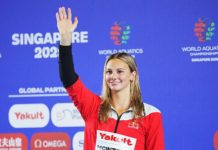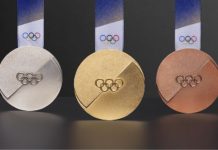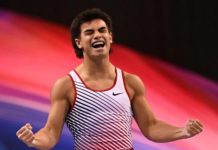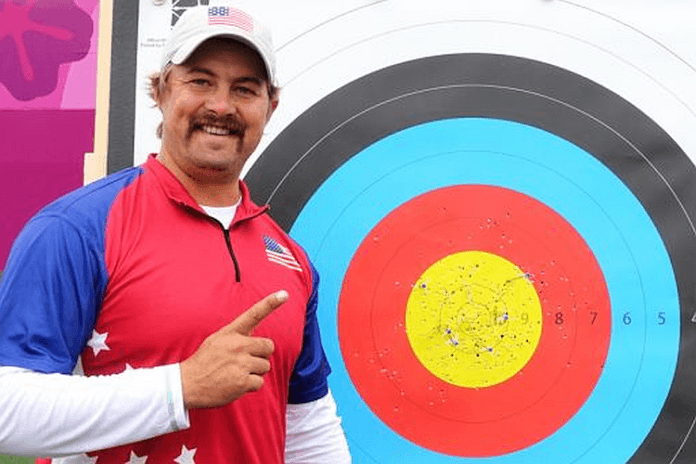= TSX DAILY ~ 7 August 2019 =
| 1. | LANE ONE: Did you see where Germany drew 178,000 for ten national championships on one weekend in Berlin?
The city of Berlin, working in coordination with the national governing bodies in 10 sports and the two national over-the-air broadcasters, created Die Finals Berlin 2019 with events over six days, but primarily on last Saturday and Sunday (3-4 August).
Hoping for 70,000 attendees, the combined program drew an astonishing 178,000 spectators who paid to see athletics, boxing, track cycling, gymnastics and swimming. Hundreds of thousands more saw archery, canoeing, modern pentathlon, mountain biking and triathlon events for free.
At the Olympiastadion, the German track & field championships drew 60,550 for two days, including a record crowd of 34,350 for Sunday’s events.
Could this be done in the U.S.? The program in Berlin was promoted for a full year, was on national television (and streaming) live and had each of the 10 national federations running their own programs that were marketed under a common umbrella.
The U.S. Olympic Committee tried analogous events in the past and failed. But not multiple national championships and in fact, the USOPC would not need to be involved at all. The U.S. National Governing Bodies could do this on their own.
Will they? Will a U.S. city step up? Can the Olympic Movement in the U.S. afford to miss an opportunity like this?
| 2. | PAN AMERICAN GAMES: Swimming and track take over and U.S. now at 62 golds and 157 total medals
The first day of swimming and first full day of track & field headlined Tuesday’s events at the 2019 Pan American Games in Lima (PER). In comparison to some spotty attendance at some of the first-week events, the stands were mostly full at the National Sports Village Aquatics Center and Athletics Stadium.
The U.S. stood out in the swimming, of course, despite the Pan Ams being assigned essentially the “third team” for 2019 by USA Swimming, behind the FINA World Championships in Gwangju (KOR) and the World University Games in Naples (ITA). Nevertheless, the Americans claimed three wins on Tuesday:
● Andrew Abruzzo, 19, won the 400 m Free in 3:48.41, more than a second ahead of Brazil’s Fernando Scheffer (3:49.60).
● Annie Lazor (pictured below), who stands no. 3 on the world list for 2019 (1:06.03) got to the touch first in the 100 m Breaststroke in 1:06.94, ahead of Julia Sebastian (ARG: 1:07.09). It’s the sixth straight time the U.S. women have won this event in the Pan American Games.
● The women’s 4×100 m Free relay survived a modest lead-off leg from Lia Neal (55.67), but Claire Rasmus (54.51) got close to the lead and veteran Kendyl Stewart (55.05) took the lead for good. Anchor Margo Geer sprinted to a half-body length lead at the final turn and then held on for a 54.36 leg and a win in 3:39.59, with Brazil second (3:40.39). The U.S. women have won this event now 16 of the 18 times it has been held.
Brazil’s Joao de Deus won the men’s 200 m Butterfly for the third Pan American Games in a row, building a big lead and then holding off American Sam Pomajevich, 1:55.86-1:57.35.
The Brazilians were also the heavy favorite in the men’s 4×100 m Free relay and their quartet of Breno Correia, Marcel Chierighini, Bruno Fratus and Pedro Spajari won for the sixth straight Pan Am Games in 3:12.61, well ahead of the U.S. (3:14.94). One important note for American fans was the 47.70 anchor by the amazing Nathan Adrian, who had the second-fastest split in the entire race as he continues his recovery from testicular cancer.
The first full day of track & field was held in blustery conditions on Tuesday, with a crackerjack competition in the women’s discus. World leader Yaime Perez of Cuba was the favorite, but trailed Brazil’s Andressa Oliveira de Morais all through the event. The Brazilian set a national record of 65.98 (216-6) on her second throw and led right down to the final two throws.
Perez, standing second at 64.65 m (212-1), showed almost no emotion throughout the event and looked positively grim coming into the ring in the sixth round. But she turned tightly in the circle and sailed the disc well beyond the last measuring line and it bounced at 66.58 (218-5) to give her the lead … and Perez sort of grimaced.
But when Oliveira de Morais fouled on her throw, Perez actually smiled and moved from up silver in 2015 to the top of the podium in 2019. It the fourth straight PAG gold for Cuba in the women’s discus.
The men’s disc had a lot less drama, as world no. 2 Fedrick Dacres of Jamaica won easily, throwing 67.68 m (222-0), ahead of teammate Traves Smikle (65.02 m/213-4) and Reggie Jagers of the U.S. (64.48 m/211-6). It was Dacres’s second straight Pan Am Games gold in the event.
With temperatures in the high 50s (F), times were slow in the heats of the men’s 100 m. Brazil’s Rodrigo Pereira do Nascimento led all qualifiers at 10.27, with American Mike Rodgers at 10.29. Jamaica’s Olympic Champion from 2016, Elaine Thompson, ran 11.36 for the fastest time of the day.
There was a lot more action all across the Games, including:
● Fencing: Family ties were all over the fencing competition, as American Gerek Meinhardt led a 1-3 finish (with Race Imboden) in the men’s Foil competition. Meinhardt is the fiancé of American Lee Keifer (both pictured above), who won the Foil title on Monday.
Further, two of the three fencing Limardo Gascon brothers from Venezuela faced off in the final of the men’s Epee, with 2012 Olympic Champion Ruben – now 34 – defeating younger brother Jesus (23) in 40 minutes by 15-8. It was Ruben’s third Pan American Games gold medal after titles in 2007 and 2015.
The U.S. collected a third fencing gold in the women’s Sabre, thanks to Eliza Stone.
● In Table Tennis, the top hope for the U.S. men in Tokyo is 19-year-old Kanak Jha and he started his week in Lima with a bronze medal with Yue Wu (29) in the Mixed Doubles, his first medal in a major Games. Wu came back to team with Lily Zhang to win the silver in women’s Doubles.
After 11 full competition days in Peru, the U.S. continues its march at the top of the medal table, with 157 medals (62-51-44), ahead of Canada (97: 24-40-33) and Brazil (88: 27-22-39). That’s with just 215 of the 419 events completed and a rush of finals in the coming days.
For comparison, in 2015 in Toronto (CAN), the U.S. led the medal table with a total of 265 (103-82-80), ahead of Canada (219) and Brazil (141). You can check on all of the results from Lima here.
| 3. | CYCLING: Fourth stage of the Tour de Pologne held as a procession in honor of Bjorg Lambrecht
The unimaginable tragedy of the death of 22-year-old Bjorg Lambrecht of Belgium (and the Lotto-Soudal Team) during the third stage of the Tour de Pologne on Monday was respected by the race and the riders on Tuesday as the course was covered by the riders in memoriam, with no results.
The planned route was shortened from 173.3 km to 133.7 km and the Lotto-Soudal team rode in front of the peloton to the 48 km point, which is where Lambrecht crashed on Monday. A moment of silence was held and then the teams took turns at the front of the race at a pre-set pace, ending with the Lotto-Soudal team crossing the finish line first.
Cycling World reported that “A black banner had been put up in place of a finish line, with Lambrecht’s name and his race number 143 in white letters.”
The Tour will return to racing tomorrow for Stage 5, a 153.8 km ride over a hilly course from Wieliczka to Bielsko-Biala, with Germany’s Pascal Ackermann in the lead over Fernando Gaviria (COL: +0:12). The event continues through Friday; look for results here.
| 4. | SWIMMING Preview: FINA World Cup moves to China, but Hosszu and Simonova enter 14 events again!
The second of seven legs in the FINA Swimming World Cup is in Jinan (CHN) this week, with a weaker field that attended the opener in Tokyo. But once again, the focus will be on series leaders Vladimir Morozov (RUS) and Katinka Hosszu (HUN).
Both won three events in Tokyo and will try to extend their advantages in China in the second of the three meets in the first World Cup “cluster.” Their motivation? The cluster winners each receive a bonus of $50,000!
Hosszu entered 14 events in Tokyo, but scratched down most of her schedule. However, Russian Vitalina Simonova, whose primary claim to fame is a 2013 European silver medal in the 200m Breast, entered 14 events and swam in them all. The only made the final in one event – the 200 m Breast – where she finished seventh, but it was an impressive feat. Our preview is here.
| 5. | VOLLEYBALL Preview: Men’s Olympic qualifying tournaments will award six spots this weekend
Like the women’s events last week, six tournaments of four teams each will be held around the world, with the winners each awarded a place in the 2020 Tokyo Olympic Volleyball field.
Japan is already in, of course, as the host country. The favorites in this week’s events include Brazil (no. 1 in the world rankings), the U.S. (2), Italy (3), Poland (4), Russia (5) and Canada (6).
The U.S. will play in Rotterdam (NED) against Belgium, the Netherlands and South Korea. Our preview is here.
| 6. | ATHLETICS: AIU reports out-of-competition drug testing up almost 30% in 2018
The IAAF-funded, but fully independent Athletics Integrity Unit proudly posted its testing collection statistics on the home page of its Web site, but they actually have a lot more to crow about.
The numbers showed 8,489 total tests carried out in 2018, but the comparisons to 2017 make the numbers much more meaningful:
Total samples collected:
● 7,435 in 2017
● 8,489 in 2018, +14.2%
Samples collected out-of-competition:
● 4,626 in 2017
● 6,007 in 2018, +29.9%
Samples collected in-competition:
● 2,809 in 2017
● 2,482 in 2018, -11.6%
Many doping-control activists have called in-competition tests almost worthless, since athletes know they will be tested. The significant increase in the number of out-of-competition tests is a good sign for better follow-up and better intelligence from the AIU. They should promote those rises in out-of-competition tests and total tests rather than just posting the 2018 numbers alone.
























